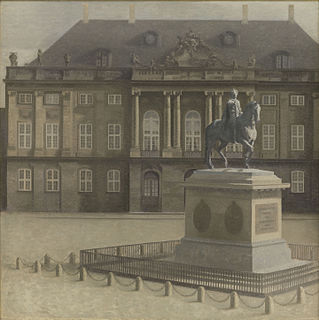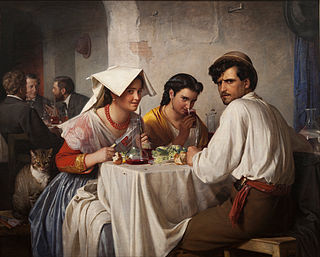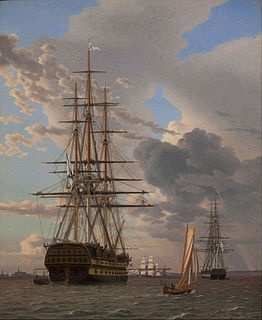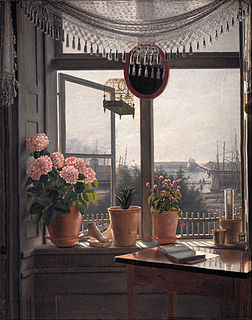 W
WAlice is a c.1918 oil on canvas painting by Amedeo Modigliani. It now hangs in the Danish National Gallery, to which it was donated in 1928.
 W
WAmalienborg Square, Copenhagen is an 1896 oil on canvas painting by the Danish artist Vilhelm Hammershøi in the Statens Museum for Kunst.
 W
WAn Egyptian Pot Seller at Gizeh is one of several paintings of Oriental women by Polish-Danish painter Elisabeth Jerichau-Baumann. It is considered one of her best works.
 W
WThe artist's mother Ane Hedvig Brøndum in the blue room is a painting by Anna Ancher from 1909.
 W
WBella and Hanna. The Eldest Daughters of M. L. Nathanson is a painting by the Danish painter, C. W. Eckersberg. It was painted in 1820.
 W
WBlack Woman with Child is a circa 1650 full-length portrait painting by Albert Eckhout. It is in the collection of the National Gallery of Denmark.
 W
WThe Christ as the Suffering Redeemer is a painting by the Italian Renaissance artist Andrea Mantegna, dated to c. 1488–1500 and housed in the Statens Museum for Kunst, Copenhagen, Denmark.
 W
WThe Eruption of Vesuvius is the name of several paintings by the Norwegian artist Johan Christian Dahl, executed from 1820 to 1826. He travelled to Italy in 1820, spending a short time in Rome before moving on to Naples, arriving in time for the eruption of Mount Vesuvius in December that year. He was one of the first to climb the mountain. There are at least seven versions of the painting, three are exhibited in the Danish National Gallery in Copenhagen, in the Kode Museum in Bergen, and the final one in Städel Museum in Frankfurt.
 W
WThe Fall of the Titans is an oil painting of the Titanomachy by the Dutch painter Cornelis van Haarlem in 1588–1590. It measures 239 × 307 cm (94 × 121 in). The work is in the collection of the Statens Museum in Copenhagen, Denmark. It is an ambitious work of the Haarlem Mannerists, and a display of the artist's ability to devise and depict a large number of varied poses for the male nudes.
 W
WLa Femme au Cheval is a large oil painting created toward the end of 1911, early 1912, by the French artist Jean Metzinger (1883–1956). The work was exhibited in Paris at the Salon des Indépendants in 1912 and the Salon de la Section d'Or, 1912. The following year La Femme au Cheval was reproduced in The Cubist Painters, Aesthetic Meditations by Guillaume Apollinaire (1913).
 W
WThe Green Stripe, also known as Portrait of Madame Matisse. The Green Line, is a portrait by Henri Matisse of his wife, Amélie Noellie Matisse-Parayre. It is an oil painting on canvas, completed autumn or winter 1905. It is named for the green band that divides the face in half, by which Matisse sought to produce a sense of light, shadow, and volume without using traditional shading. Matisse's colorism was shocking at the time. When the painting was exhibited in Paris in 1906 such works were being derisively labeled as the creations of Les Fauves, along with similar works of André Derain and Maurice de Vlaminck.
 W
WA Group of Danish Artists in Rome is an 1837 oil painting by the Danish Golden Age artist Constantin Hansen. The work depicts a group of Danish painters, architects, and other artists in a Roman hotel room; those painters depicted are Hansen himself, Michael Gottlieb Bindesbøll, Martinus Rørbye, Wilhelm Marstrand, Albert Küchler, Ditlev Blunck, and Jørgen Sonne.
 W
WIn a Roman Osteria is a painting by the Danish painter Carl Bloch. It was painted in 1866.
 W
WIn the garden door. The artist's wife is an oil painting by L. A. Ring in 1897. It is a portrait of his wife Sigrid Kähler (1874-1923), whom he married in 1896. The painting is 191 × 144 cm and is owned by the National Gallery of Denmark.
 W
WMan in a Plumed Beret is a c.1659-1661 oil on canvas painting attributed to Rembrandt.It is now in the National Gallery of Denmark in Copenhagen.
 W
WThe Marble Steps Leading to the Church of Santa Maria in Aracoeli in Rome is a painting by the Danish painter, C. W. Eckersberg. It was painted in 1814–1816.
 W
WMelancholia is a 1532 oil on panel painting by Lucas Cranach the Elder, now in the National Gallery of Denmark in Copenhagen.
 W
WMen of Skagen on a Summer Evening in Fair Weather is an 1848 painting by Martinus Rørbye, one of the central figures of the Golden Age of Danish Painting.
 W
WPortrait of Don Miguel de Castro, Emissary of Congo is a 1643 painting by the Dutch Golden Age painter Jasper or Jeronimus Becx. It was earlier attributed to Albert Eckhout.
 W
WPortrait of Lorenzo Cybo (1524) is a painting by the Italian late Renaissance artist Parmigianino. It is housed in the Statens Museum for Kunst, Copenhagen, Denmark.
 W
WPortrait of the Sculptor Jens Adolf Jerichau, the Artist's Husband is a portrait of the Danish sculptor Jens Adolf Jerichau painted in 1846 by Elisabeth Jerichau-Baumann, the same year they married.
 W
WThe Reverse of a Framed Painting is a still life trompe-l'œil painting by Flemish painter Cornelius Norbertus Gysbrechts, made in 1670, when the artist was working as the official painter of the Danish royal court. The painting is commonly considered a masterpiece of trompe-l'œil painting for its deceptively sculptural representation of the back of a framed painting in a canvas.
 W
WThe Russian Ship of the line "Asow" and a Frigate at Anchor in the roads of Elsinore is a painting by the Danish painter, C. W. Eckersberg. It was painted in 1828.
 W
WA Seascape. The Coast of the Island of Rügen in Evening Light is an 1818 oil on canvas marine painting by J.C. Dahl, measuring 37 cm by 58.5 cm and now in the Danish National Gallery, which purchased it at auction in 1975. It was his first marine painting and the first work he produced in Dresden. A signed compositional drawing for it is now in the Bergen Museum of Art.
 W
WSelf-Portrait in a Striped T-shirt (1906) is an oil on canvas painting by Henri Matisse from his Fauvism period, in the collection of Statens Museum for Kunst, Copenhagen, Denmark.
 W
WView from the Artist's Window is a painting from 1825 by Martinus Rørbye, a Danish Romantic genre, landscape and architecture painter. It is in the Statens Museum for Kunst in Copenhagen. The painting is considered one of the highlights of the Danish Golden Age painting. It incorporates themes and symbols that resonated with its audience.
 W
WA View through Three of the North-Western Arches of the Third Storey of the Coliseum is a painting by the Danish painter C. W. Eckersberg. It was painted in 1815 or 1816 when Eckersberg sojourned in Rome, painting a series of works of the ancient ruins of the city.
 W
WThe Wounded Philoctetes is a painting by the Danish painter, N. A. Abildgaard. It was painted in 1775.
 W
WA young artist considers a sketch in a mirror is a painting by Wilhelm Bendz from 1826; it is one of the series of Danish Golden Age portraits of artists.